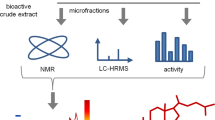Abstract
Traditionally, active compounds were discovered from natural products by repeated isolation and bioassays, which can be highly time consuming. Here, we have developed a data mining approach using the casual discovery algorithm to identify active compounds from mixtures by investigating the correlation between their chemical composition and bioactivity in the mixtures. The efficacy of our algorithm was validated by the cytotoxic effect of Panax ginseng extracts on MCF-7 cells and compared with previous reports. It was demonstrated that our method could successfully pick out active compounds from a mixture in the absence of separation processes. It is expected that the presented algorithm can possibly accelerate the process of discovering new drugs.



Similar content being viewed by others
References
Attele AS, Wu JA, Yuan CS (1999) Ginseng pharmacology: multiple constituents and multiple actions. Biochem Pharmacol 58:1685–1693
Borisy AA, Elliott PJ, Hurst NW, Lee MS, Lehar J et al (2003) Systematic discovery of multicomponent therapeutics. Proc Natl Acad Sci USA 100:7977–7982
Butcher EC, Berg EL, Kunkel EJ (2004) Systems biology in drug discovery. Nat Biotechnol 22:1253–1259
Butterweck V, Christoffel V, Nahrstedt A, Petereit F, Spengler B, Winterhoff H (2003) Step by step removal of hyperforin and hypericin: activity profile of different Hypericum preparations in behavioral models. Life Sci 73:627–639
Cheng Y, Wang Y, Wang X (2006) A causal relationship discovery-based approach to identifying active components of herbal medicine. Comput Biol Chem 30:148–154
Claus BL, Underwood DJ (2002) Discovery informatics: its evolving role in drug discovery. Drug Discov Today 7:957–966
Corbit R, Ebbs S, King ML, Murphy LL (2006) The influence of lead and arsenite on the inhibition of human breast cancer MCF-7 cell proliferation by American ginseng root (Panax quinquefolius L.). Life Sci 78:1336–1340
Harvey A (2000) Strategies for discovering drugs from previously unexplored natural products. Drug Discov Today 5:294–300
Koehn FE, Carter GT (2005) The evolving role of natural products in drug discovery. Nat Rev Drug Discov 4:206–220
Misra R (1998) Modern drug development from traditional medicinal plants using radioligand receptor-binding assays. Med Res Rev 18:383–402
O’Connor KA, Roth BL (2005) Screening the receptorome for plant-based psychoactive compounds. Life Sci 78:506–511
Orlando M, Meredith LS (2002) Understanding the causal relationship between patient-reported interpersonal and technical quality of care for depression. Med Care 40:696–704
Plavec I, Sirenko O, Privat S, Wang Y, Dajee M et al (2004) Method for analyzing signaling networks in complex cellular systems. Proc Natl Acad Sci USA 101:1223–1228
Spirtes P, Glymour C, Scheines R (1993) Causation, prediction, and search. Springer, New York, 42 pp
Strege MA (1999) High-performance liquid chromatographic-electrospray ionization mass spectrometric analyses for the integration of natural products with modern high-throughput screening. J Chromatogr B Biomed Sci Appl 725:67–78
Tan G, Gyllenhaal C, Soejarto DD (2006) Biodiversity as a source of anticancer drugs. Curr Drug Targets 7:265–277
Wagner A (1999) Causality in complex systems. Biol Philos 14:83–101
Wang Y, Cheng Y (2003) A strategy for studies on the computational theory and methodology for identifying the composition–activity relationship of Chinese medicine. Chin J Nat Med 1:178–181
Wang Y, Pan JY, Xiao XY, Lin RC, Cheng YY (2006) Simultaneous determination of ginsenosides in Panax ginseng with different growth ages using high-performance liquid chromatography–mass spectrometry. Phytochem Anal 17:424–430
Wang Y, Wang X, Cheng Y (2006) A computational approach to botanical drug design by modeling quantitative composition–activity relationship. Chem Biol Drug Des 68:166–172
Xie P, Chen S, Liang YZ, Wang X, Tian R, Upton R (2006) Chromatographic fingerprint analysis—a rational approach for quality assessment of traditional Chinese herbal medicine. J Chromatogr A 1112:171–180
Xu D, Lu Q, Hu X (2006) Down-regulation of P-glycoprotein expression in MDR breast cancer cell MCF-7/ADR by honokiol. Cancer Lett 243:274–280
Yu FY, Lin YH, Su CC (2006) A sensitive enzyme-linked immunosorbent assay for detecting carcinogenic aristolochic acid in herbal remedies. J Agric Food Chem 54:2496–2501
Yuan CS, Wang X, Wu JA, Attele AS, Xie JT, Gu M (2001) Effects of Panax quinquefolius L. on brainstem neuronal activities: comparison between Wisconsin-cultivated and Illinois-cultivated roots. Phytomedicine 8:178–183
Acknowledgments
This project was financially supported by the Chinese National Basic Research Priorities Program (No. 2005CB523402), the Program for New Century Excellent Talents in University of China (No. NCET-06-0515) and the Science and Technology Development Program of Zhejiang Province (No. 2006C33024).
Author information
Authors and Affiliations
Corresponding author
Rights and permissions
About this article
Cite this article
Wang, Y., Jin, Y., Zhou, C. et al. Discovering active compounds from mixture of natural products by data mining approach. Med Biol Eng Comput 46, 605–611 (2008). https://doi.org/10.1007/s11517-008-0323-1
Received:
Accepted:
Published:
Issue Date:
DOI: https://doi.org/10.1007/s11517-008-0323-1




